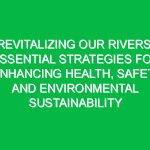Construction projects near dams present unique challenges and risks, particularly concerning water safety. The proximity to large bodies of water necessitates stringent Health Safety and Environment (HSE) measures to protect workers, the public, and the environment. This article delves into essential HSE guidelines to ensure water safety in construction near dams, aiming to foster a secure and efficient worksite.
Understanding the Risks
Before diving into the guidelines, it’s crucial to understand the risks associated with construction near dams. These include sudden water release, flooding, dam failure, and the potential for accidents due to slippery surfaces or falling into the water. Recognizing these hazards is the first step in mitigating them effectively.
Comprehensive Planning and Risk Assessment
Initial Planning
Effective water safety begins with comprehensive planning. This involves identifying potential hazards, assessing the risks, and implementing control measures. A thorough risk assessment should consider the dam’s operational schedule, historical data on water releases, and seasonal weather patterns that could affect water levels.
Emergency Response Plan
An Emergency Response Plan (ERP) is critical for construction sites near dams. This plan should include procedures for sudden water level changes, communication protocols, and evacuation routes. Regular drills should be conducted to ensure that all workers are familiar with the ERP.
Implementing Control Measures
Physical Barriers
To prevent unauthorized access to hazardous areas, physical barriers such as fencing or barricades should be erected around the construction site. These barriers not only protect workers but also secure equipment and materials from being washed away in the event of sudden water release.
Personal Protective Equipment (PPE)
Ensuring that all workers are equipped with appropriate PPE is paramount. This includes life jackets for those working near or on the water, slip-resistant footwear, and helmets. PPE should be regularly inspected and maintained to ensure its effectiveness.
Training and Awareness
Training plays a vital role in water safety. Workers should be educated on the specific hazards of working near dams, the importance of adhering to safety protocols, and how to respond in an emergency. Awareness campaigns can reinforce the significance of water safety and encourage a culture of safety on the construction site.
Monitoring and Communication
Water Level Monitoring
Continuous monitoring of water levels is essential, especially during periods of heavy rainfall or when the dam is releasing water. Automated alarm systems can provide early warnings of sudden changes, allowing for timely evacuation if necessary.
Effective Communication
Clear and effective communication channels must be established to disseminate information quickly in an emergency. This includes having a reliable method of alerting workers, such as loudspeakers or alarm systems, and ensuring that all workers are aware of the communication protocols.
Collaboration with Dam Operators
Collaboration with dam operators can significantly enhance water safety. Construction managers should establish a line of communication with the dam’s operators to receive timely information on water releases and any potential hazards. This partnership can also facilitate the sharing of best practices and safety measures.
Environmental Considerations
Construction near dams also has environmental implications. Erosion control measures should be implemented to prevent sediment from entering the water, which can harm aquatic ecosystems. Additionally, care should be taken to avoid contaminating the water with construction materials or chemicals.
Regulatory Compliance
Adhering to local and national regulations is a legal requirement for construction projects near dams. This includes obtaining the necessary permits and ensuring that all construction activities comply with environmental and safety standards. Regular audits and inspections can help maintain compliance and identify areas for improvement.
Summary of Key Points
Ensuring water safety in construction near dams requires a multifaceted approach that encompasses comprehensive planning, risk assessment, implementation of control measures, training, monitoring, and effective communication. Collaboration with dam operators and adherence to regulatory requirements are also crucial. By following these essential HSE guidelines, construction managers can create a secure worksite that protects workers, the public, and the environment.
Remember, water safety is not just a regulatory requirement but a moral obligation to ensure the well-being of all individuals involved in or affected by construction activities near dams. Let’s work together to maintain a safe and healthy environment for everyone.


